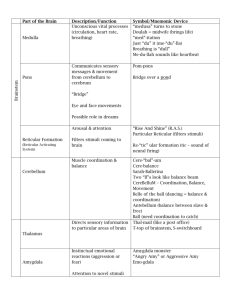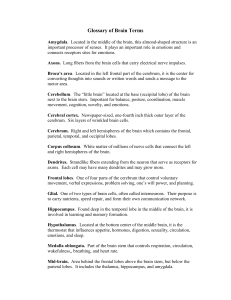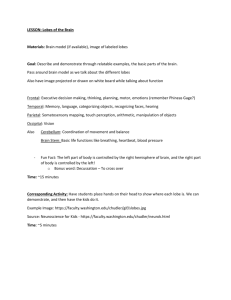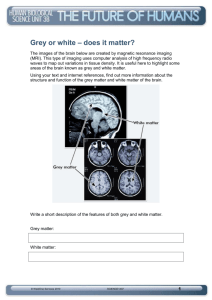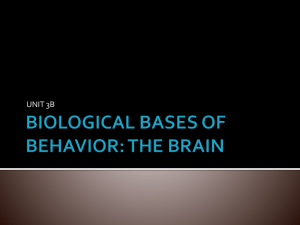Prof.Dr. Ramez N. Bedwani
advertisement
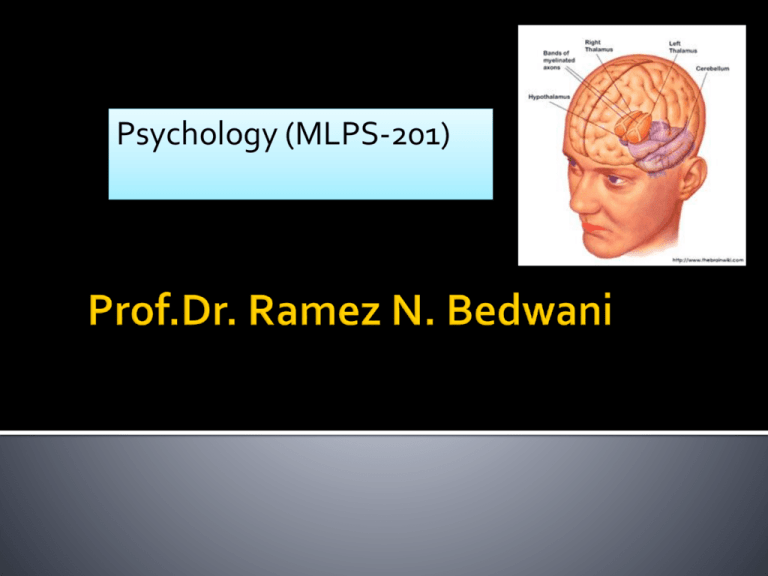
Psychology (MLPS-201) By the end of the lecture the students will Recognize the different parts of the brain are linked to carry different cognitive, sensory and motor functions controlling wellbeing of the individual Understand the effect of sensory deprivation on different psychological functions. Reticular Activating System: It is a network of never fibers extending from the brain stem to the cerebrum that is involved in one’s level of arousal or activation, so acting like a valve that either allows sensory messages to pass from lower centers up to the higher centers of the brain or shuts them off, partially or totally. Limbic System: It is a collection of small structures, including the amygdale, septal area, and the hippocampus that are involved in emotional and motivational reactions, both showing opposite effects to each other, with respectively produced aggression and rage attributed to amygdale stimulation. Hippocampus is responsible for transfer of memories to long-term storage. It is a small structure near the center of the brain that is considered to be part of the limbic system. It is involved in feeding, drinking, temperature regulation as well as regulation of the endocrine system. It is the final sensory relay station that projects sensory fibers to their proper location in the cerebrum and that may be involved in regulating sleep-wake cycles. Sensory messages from the lower body, eyes, ears and other senses (except for smell) pass through the thalamus. The cerebral cortex (cerebrum); It is a large convoluted outer covering of the brain that is the seat of cognitive functioning and voluntary action. It is formed of 2 symmetrical hemispheres (Rt & Lt) that are separated by a deep fissure running from the front to the back. Each cerebral hemisphere is formed of 4 lobes. The frontal lobes: which are the largest and defined by 2 large fissures called the central and lateral fissures. It is present in front of the central fissure and above the lateral fissure. The occipital lobes: they are the lobes of the cerebrum at the back of the brain. the parietal lobes: they are the lobes of the cerebrum between the frontal lobes and the occipital lobes and above the lateral fissure. The temporal lobes: they are located at the temple below the lateral fissure and in front of the occipital lobes. Functionally these lobes constitute sensory areas. Motor areas and association areas. They are those, areas of the cerebral cortex that receive impulses from our sense receptors. Receptor cells in our senses respond to environmental stimuli to send impulses along sensory nerve fibers to the spinal cord through the brain stem to the thalamus then finally to a variety of sensory areas depending on the senses Visual impulses end in the occipital lobe concerning the visual area. Auditory impulses end in the temporal lobe concerning the auditory area. Body senses (touch, pressure, pain) send impulses to the front of the parietal lobe where specific body regions are mapped with different ratios of representation as. Areas like the face, lips, fingers which are highly sensitive are over represented in the body sense area of the cerebrum. It would be important to reintroduce the concept of cross-laterality which means that, in general, sensory and motor impulses to and from the brain cross from the left side of the body to the right side of the brain, and vice versa. It is the area that controls voluntary movement, which is present at the back of the frontal lobe. The actual decision-making step of whether or not one should move is probably made toward the front of the frontal lobe. Concept of cross-laterality is also applied to the motor area. As with the body sense mapping, different parts of the body and the muscles serving them are disproportionally represented in the cerebral cortex motor area Remaining areas of the cerebrum are called association areas, they are three: frontal, parietal and temporal. No occipital association area. Association areas are concerned of processing higher mental activities and it is where incoming sensory information is associated. Frontal association areas are responsible or language and speech behaviors as their destruction causes inability to plan ahead, to think quickly or to think things thoroughly. Both cerebral hemispheres are interconnected with a network of nerve fibers that send impulses between the two hemispheres. Lt cerebral hemisphere is connected with speed and language, it is also responsible for simple tasks of calculation. It is also concerned with analytical thinking. It seems also to process information sequentially handles one thing at a time. Rt cerebral hemisphere seems more global in its approach and seems better able to grasp the big picture, to see the overall view of an issue, and to be more creative, more spatially and visually oriented than the left hemisphere. It is also useful in solving spatial relations tasks. Also concerned with more visual imagery than does the left hemisphere, more musical. Rt cerebral cortex is more involved in expression and interpretation of emotions. Most of what we know about the activities of the cerebral hemispheres has been learnt from splitbrain subjects. Split brain is a procedure of separating the functioning of the two cerebral hemispheres by destroying the corpus callosum. It is of interest to mention that split-brain patients appear to behave quite normally and that only in laboratory we can see the results of having made the hemispheres of the cerebrum function independently. It is utilization of isolation or reeducation of exteroceptive stimulation in the psychology functioning. Perception; In the psychological laboratories, the methodological problems for investigating sensory deprivation are great. Moreover, the conclusions must be taken honestly as situation in life differ from those in the experiments. Psychoanalytic: One function of the ego is mastering the external reality. Under S.D., psychological processes become dominated by more primitive “primary thinking”. Neuropsychological: Normally, the reticular activating system is a homeostatic system adjusting inputs and outputs relations. In S.D., there is lowered arousal and loss of selective attention that leads to reactivation of residual stimuli. Psychoanalytic Cognitive: perception operates on a system of probabilities, creating a cognitive model useful in programming the reticular activating system to select stimuli, that is corrected by feedback information in S.D., reduced sensory cues, interferes with the feedback. The individual cognitive processes become disorganized. On psychological functions: Affective changes: Negative: In normal, in the form of boredom, restlessness anxiety and depersonalization, short lived, reversible. Positive: In psychiatric patients, in the form of improved mood, long lasting. Perceptual changes: Hallucinations (true, imageries), for 10 to 20 years of subjects. Cognitive: Defective concentration, impaired intellectual and learning abilities. Motorceptic performance changes. Susceptibility to propaganda (brain washing): May be increased with liability towards attitude changes. Brain activities and EEG: Progressive slowing, continues after S.D. for hours or weeks. Skin conductance, tactile activity and pain sensitivity: Are increased but are short-lived. Biochemical measures: Others: Inconclusive changes of body temperature, circulation and respiration. Military and industrial aspects: Accident proneness and errors of judgment. Also, in superhighways and prisons. Medical wards (e.s.): Neurology, ophthalmogy, orthopedics, and postoperative recovery rooms. Psychiatric aspects: Developmentally: Results in impaired intellectual and emotional growth. Consultations: Periods of S.D. can add secondary psychiatric symptomatology. Isolation of the mental patients: provides gradual deterioration. Geriatric subjects: Due to cultural patterns and physical limitations may deteriorate furtherly. Psychiatric treatment: Short periods of S.D. may be beneficial for some psychotic and depressed patients. All correct except one 1. The hypothalamus is envolved in 2. Feeding and drinking 3. Temperature regulation 4. regulation of endocrine system 5. Motor power Complete 1-The 4 lobes of the brain are a) Frontal lobes b) Occipital lobes c) Parietal lobes ……………. 2-Sensory deprivation affects a) psychological functions b) ………………………..
